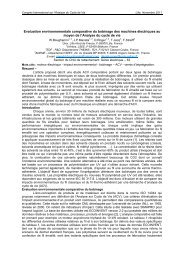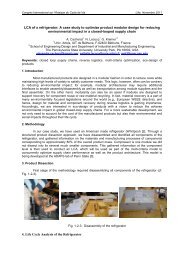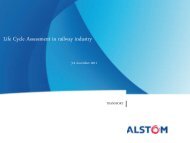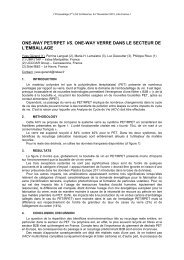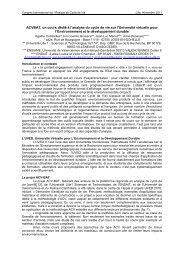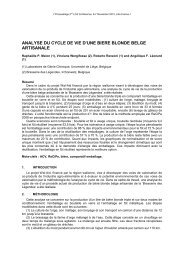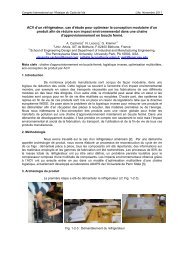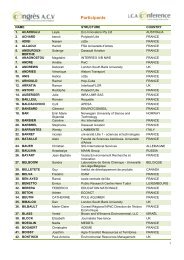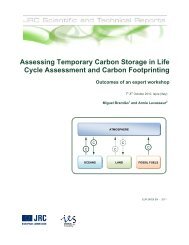Untitled - avniR
Untitled - avniR
Untitled - avniR
Create successful ePaper yourself
Turn your PDF publications into a flip-book with our unique Google optimized e-Paper software.
Congrès International sur l’Analyse du Cycle de Vie Lille, Novembre 2011<br />
Development of data base for simplified Life Cycle Assessment (LCA) of Textiles<br />
Marie de Saxcé 1,2,3, Anne Perwuelz 2,3, Besoa Rabenasolo 2,4<br />
1 Université Lille Nord de France, F-59000 Lille, France<br />
2 ENSAIT, GEMTEX, F-59056 Roubaix, France<br />
stenter3 ECLille, LM2O, 59000 Lille, France<br />
marie.desaxce@ensait.fr , anne.perwuelz@ensait.fr, besoa.rabenasolo@ensait.fr<br />
Section du CNU de rattachement:61/62<br />
Key words: Simplified life cycle assessment, Data base, Textile LCA Software/ Interface<br />
This paper first outlines the specific needs and requirements of such a database, then describes<br />
how the textile LCA can be simplified and finally focuses on eventual optimizations of a textile LCA<br />
software and database.<br />
1 Textile LCA database specific needs and requirements<br />
1.1 Methodology for the development of Life Cycle Inventory (LCI) data sets<br />
Prior to collection and collection planning, quality goals should be defined [11] such as: prefer on<br />
site collection with regard to technical representativeness, ensure geographical representativeness with<br />
country specific processes, do not collect data before 2000 to obtain a good temporal representativeness.<br />
Indeed, the constant technological progress quickly makes old technologies obsolete. For instance cotton<br />
seed yields increased from 0,86 T/Ha in 1961 to 2,14 T/Ha in 2007 [12].<br />
The following steps describe a general LCI data set development method [13,14]: identify<br />
processes in attributional modelling; collect unit process LCI data: list all input and output flows related to<br />
the activity considered; model the system in the software and document it according to ISO 14048,<br />
calculate LCI results and validate.<br />
Among all the LCI data sets, EIME–TEX and ILCD databases differentiate: “materials production”,<br />
“processes”, “end of life treatments”, “energy carriers and technologies” and “systems”. The next<br />
paragraph describes the specificities of process LCI data sets.<br />
1.2 LCI data sets of processes<br />
All processes are identified within a life cycle phase: manufacturing, distribution, use or end of life.<br />
For each life cycle step a different inventory methodology must be applied. Manufacturing and distribution<br />
specificities are outlined in the following.<br />
Manufacturing processes take into account: the type of input, the reference flow characteristics,<br />
the machinery used, the specific treatment protocol e.g. chemical auxiliaries and processing time, the<br />
outputs and the treatment of these outputs e.g. water emissions or wastes. For each process in the<br />
manufacturing, the most important parts of the scope definition to be considered are the system<br />
boundaries and the functional unit. And in accordance with Duflou [15] the machine tool architecture and<br />
process parameters are also investigated; and all sub-processes, including sub-units, are identified and<br />
located within the machine tool.<br />
On the other hand, distribution processes take into account: distances, means of transportations<br />
(boat, plane, and truck), mass and volume of goods transported.<br />
2 Simplified Textile life cycle modelling on software<br />
2.1 Methodology for simplified life cycle assessment of textiles<br />
There are two different approaches to simplify the textile life cycle modelling. First, refer to different<br />
Product Category Rules (PCR) for Environmental textile Product Declarations (EPD). They aim at<br />
standardizing and simplifying the modelling of a specific product. They provide modelling constants and<br />
specify which environmental data must be specific and which ones can be generic according to their<br />
respective influences on LCIA results. Second, the LCA software methodology can also simplify the life<br />
cycle modelling procedure. EIME TEX Designer method for instance does not require the manipulation of<br />
11 B. Weidema, Data quality management for life cycle inventories-an example of using data quality<br />
indicators, Journal of Cleaner Production, 1996<br />
12 Secrétariat de la CNUCED d’après les données statistiques de la FAO (coton-graine)<br />
13 ILCD Handbook - Specific guide for Life Cycle Inventory data sets, European Commission & Joint Research Center,<br />
2010<br />
14 ISO 14044 : Environmental management – Life cycle analysis – Requirements and guidelines, Afnor<br />
certification, 2006<br />
15 J.R. Duflou, Unit process impact assessment for discrete part manufacturing: A state of the art, CIRP<br />
Journal of Manufacturing Science and Technology (2010), 2010<br />
- 97 -



